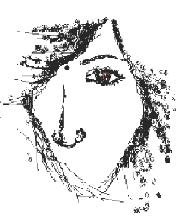 Standing Vishnu as Keshava;
Standing Vishnu as Keshava; Hoysala period (1022–1346);
first quarter of 12th centuryKarnataka (probably Belur),India;
Stone;
The Hoysala rulers of the Mysore area of southwest India began to establish power during the eleventh century. They consolidated their kingdom early in the twelfth century and began an active program of temple construction—those at Belur and Halebid among the most famous. Stylistically, Hoysala sculpture is quite unlike other Indian sculpture. It sometimes appears stolid and heavy, and is distinguished by an emphasis on pierced openwork canopies and fretwork, with the play of light over highly decorative surfaces.
This large image of Keshava, one of the twenty-four manifestations of Vishnu, is a Hoysala masterpiece. Vishnu is in the hieratic samabhanga posture, with both feet uniformly placed on a flat lotus pedestal. His consorts, Shridevi and Bhudevi, flank him. The upper portion of the sculpture has a decorative outer perimeter composed of the stylized tails of two makaras, mythological composite aquatic creatures who symbolize auspiciousness. Surrounding Vishnu's head are his ten avatars, starting with the Matsya (fish manifestation) and, moving clockwise, ending with a seated Kalki holding a sword and shield.
This sculpture is inscribed with the name of its carver. On the bottom register, in the center, an inscription records the image as the work of Dasoja of Balligrama, an artist known to us from other inscribed images at Belur, where he and his son Chavana worked.
This large image of Keshava, one of the twenty-four manifestations of Vishnu, is a Hoysala masterpiece. Vishnu is in the hieratic samabhanga posture, with both feet uniformly placed on a flat lotus pedestal. His consorts, Shridevi and Bhudevi, flank him. The upper portion of the sculpture has a decorative outer perimeter composed of the stylized tails of two makaras, mythological composite aquatic creatures who symbolize auspiciousness. Surrounding Vishnu's head are his ten avatars, starting with the Matsya (fish manifestation) and, moving clockwise, ending with a seated Kalki holding a sword and shield.
This sculpture is inscribed with the name of its carver. On the bottom register, in the center, an inscription records the image as the work of Dasoja of Balligrama, an artist known to us from other inscribed images at Belur, where he and his son Chavana worked.



No comments:
Post a Comment